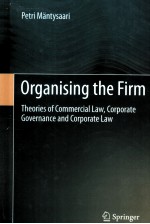

ORGANISING THE FIRM THEORIES OF COMMERCIAL LAWPDF电子书下载
- 电子书积分:9 积分如何计算积分?
- 作 者:CORPORATE GOVERNANCE AND CORPORATE LAW
- 出 版 社:SPRINGER
- 出版年份:2012
- ISBN:3642221963
- 页数:167 页
1 Introduction 1
2 Economic Theories of the Firm 5
2.1 General Remarks 5
2.2 Production Function 6
2.3 Governance Structure or Organisational Construction 7
2.4 Personification of the Firm, Authority 8
2.4.1 General Remarks 8
2.4.2 Personification 8
2.4.3 Authority 11
2.5 Summary 12
3 Theory of Commercial Law: Past Approaches 15
3.1 Introduction 15
3.2 Research Perspectives and Approaches 16
3.3 Analysis of the History of Commercial Law 21
3.4 Doctrinal Analysis 24
3.5 Comparative Law and the Approximation of Laws 28
3.6 Philosophy of Law (Jurisprudence) 32
3.7 Economic Analysis 34
3.8 Preventive or Proactive Law 35
3.9 The Reasons for the Absence of a General Theory of Commercial Law 35
3.10 The Main Failings of the Mainstream Approaches 37
4 Theory of Commercial Law: Management-Based Commercial Law 39
4.1 General Remarks 39
4.2 The Firm 40
4.3 The Rational Decision-Making of the Firm 44
4.4 The Ultimate Goal of the Firm 44
4.5 The Legal Objectives of the Firm 45
4.6 The Legal Tools and Practices of the Firm 46
4.7 Levels of Decision-Making 47
4.8 Branches of Management-Based Commercial Law 48
4.9 Management-Based Commercial Law and Transaction Cost Economics 50
4.10 Management-Based Commercial Law and Traditional Branches of Law 52
4.11 Concluding Remarks 55
5 Theories of Corporate Law and Corporations: Past Approaches 57
5.1 Introduction 57
5.2 Legal Theories of Corporations 59
5.2.1 General Remarks 59
5.2.2 Formation and General Nature 59
5.2.3 Characteristics of the Corporation 61
5.2.4 Legal Personality 62
5.2.5 Capacity 65
5.2.6 Purpose and Object 65
5.2.7 Separation 66
5.2.8 Supranational or International Corporate Forms 67
5.2.9 Problems 68
5.3 Legal Theories of Corporate Law 69
5.3.1 General Remarks 69
5.3.2 Contract 69
5.3.3 Agency 71
5.3.4 Team Production 73
5.4 Summary 74
6 Legal and Economic Theories of Corporate Governance: Past Approaches 75
6.1 Introduction 75
6.2 Choice of Business Form and Governance Model 76
6.3 Interests 77
6.3.1 General Remarks 77
6.3.2 Guidance 78
6.3.3 The Problem of Conflicting Interests 85
6.3.4 The Problem of Separate Legal Personality 87
6.3.5 Previous Attempts to Solve the Problems 88
6.3.6 The Interests of the Firm as a Way to Solve the Problems 90
6.3.7 Summary 94
6.4 Shareholders 94
6.5 The Board 96
6.6 Summary 98
7 Theory of Corporate Governance: Proposed Legal Theory 101
7.1 Introduction 101
7.2 First Level Questions 102
7.3 The Second Level Question 104
7.4 The Third Level Question 105
7.5 The Fourth Level 106
7.6 The Entity 106
7.7 The Interests 107
7.8 The Board 107
7.9 Shareholders 110
7.10 Summary 113
8 Self-enforcing Governance Models 115
8.1 Introduction: Corporate Governance and Organisational Design 115
8.2 The Problem 118
8.3 Delegation of Power 119
8.4 Centralisation of Power 120
8.5 Delegation and Centralisation 124
8.6 How Can You Make the Model More Self-enforcing? 127
9 Corporate Governance and Innovation 129
9.1 General Remarks 129
9.2 The Problem of Measurement 130
9.3 The Innovation Team 133
9.4 Strategic Level 134
9.4.1 General Remarks 134
9.4.2 Culture 134
9.4.3 Control Structure 135
9.4.4 Ownership Structure 136
9.4.5 The Availability of Funding 137
9.4.6 The Structure of the Business Organisation 138
9.5 Operational Level 145
9.6 Summary 146
10 Theory of Corporate Law: Proposed Theory 147
10.1 General Remarks 147
10.2 Three Categories of Issues 147
10.3 Corporate Governance 148
10.4 Corporate Finance 149
10.5 Existential Issues 150
10.6 Public Policy Preferences of the State 152
References 155
